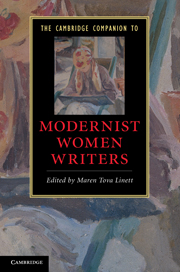Book contents
- Frontmatter
- Modernist women’s literature: an introduction
- 1 Transforming the novel
- 2 Modernist women poets and the problem of form
- 3 Women’s modernism and performance
- 4 Magazines, presses, and salons in women’s modernism
- 5 Gender in women’s modernism
- 6 Black women’s modernist literature
- 7 Race and ethnicity in white women’s modernist literature
- 8 Geomodernism, postcoloniality, and women’s writing
- 9 Women modernists and visual culture
- 10 Modernism and trauma
- 11 Political activism and women’s modernism
- 12 Religion and the occult in women’s modernism
- Guide to further reading
- Index
5 - Gender in women’s modernism
Published online by Cambridge University Press: 28 November 2010
- Frontmatter
- Modernist women’s literature: an introduction
- 1 Transforming the novel
- 2 Modernist women poets and the problem of form
- 3 Women’s modernism and performance
- 4 Magazines, presses, and salons in women’s modernism
- 5 Gender in women’s modernism
- 6 Black women’s modernist literature
- 7 Race and ethnicity in white women’s modernist literature
- 8 Geomodernism, postcoloniality, and women’s writing
- 9 Women modernists and visual culture
- 10 Modernism and trauma
- 11 Political activism and women’s modernism
- 12 Religion and the occult in women’s modernism
- Guide to further reading
- Index
Summary
In her 1928 essay A Room of One's Own, Virginia Woolf championed the ideal of the “androgynous mind,” claiming that “It is fatal to be a man or woman pure and simple; one must be woman-manly or man-womanly.” Though delivered by means of a seemingly conversational, even whimsical rhetoric, Woolf's proclamation is nonetheless one of the most revolutionary statements by a modernist woman writer advocating the overthrow of the traditional patriarchal gender roles that rendered women unequal and inferior in the perceptions of Western societies. The concept, however, was not sui generis; rather, it was the culmination of various movements advancing the cause of women's rights that had been growing since the Enlightenment, through philosophers such as Mary Wollstonecraft, Marion Reid, and John Stuart Mill. Woolf sought not only to subvert long-standing gender conventions restricting women's ability to move beyond the limitations of the domestic sphere but also, albeit more subtly, to challenge the validity of what Adrienne Rich would term “compulsory heterosexuality.” Early feminists argued for the education of women and against the legal restrictions that rendered most women little more than their husbands' chattel. Eventually women's suffrage movements arose in Britain, the United States, and other nations. While concerned primarily with gaining women's right to vote, they advocated women's property and marital rights as well.
- Type
- Chapter
- Information
- The Cambridge Companion to Modernist Women Writers , pp. 78 - 94Publisher: Cambridge University PressPrint publication year: 2010
- 1
- Cited by

